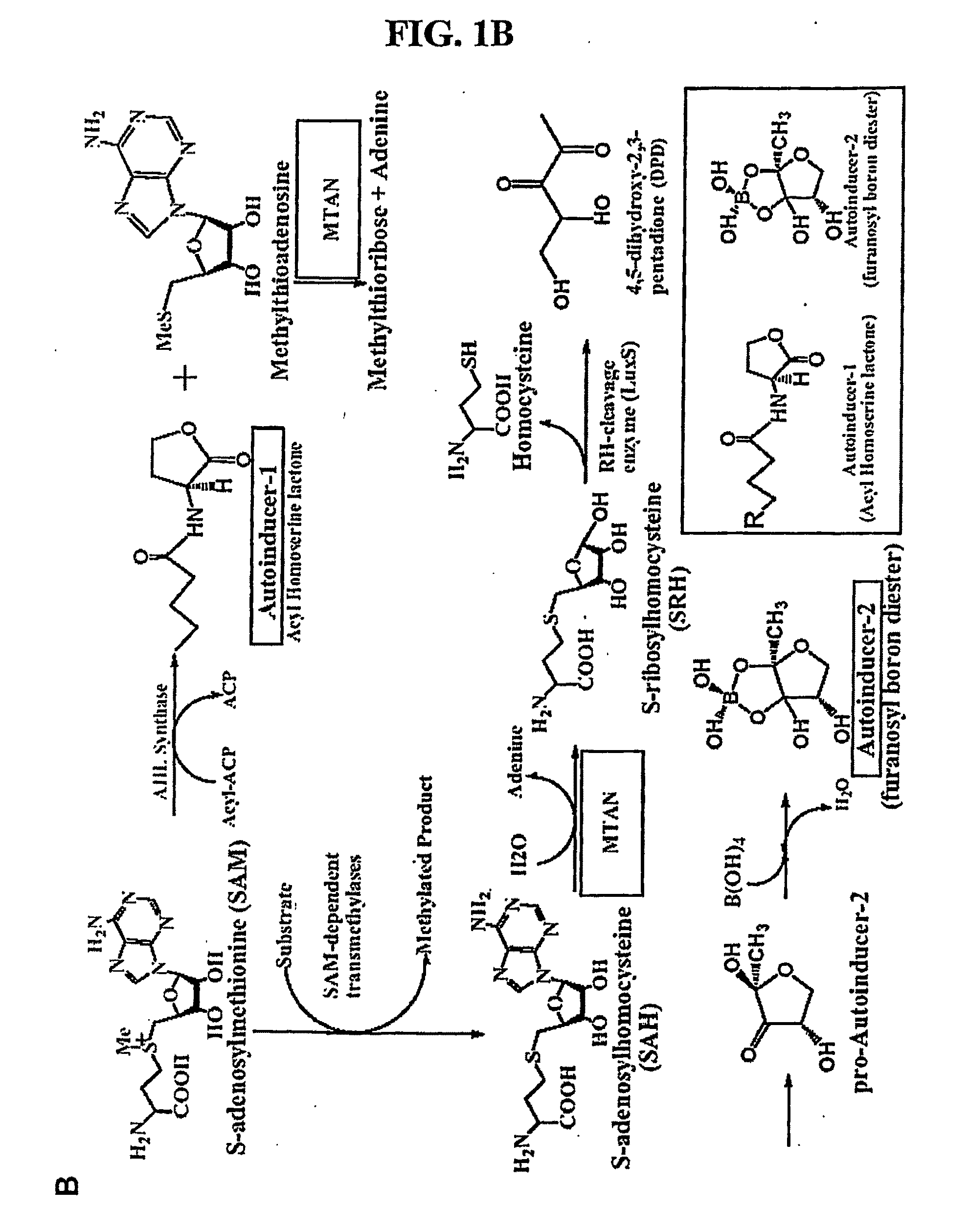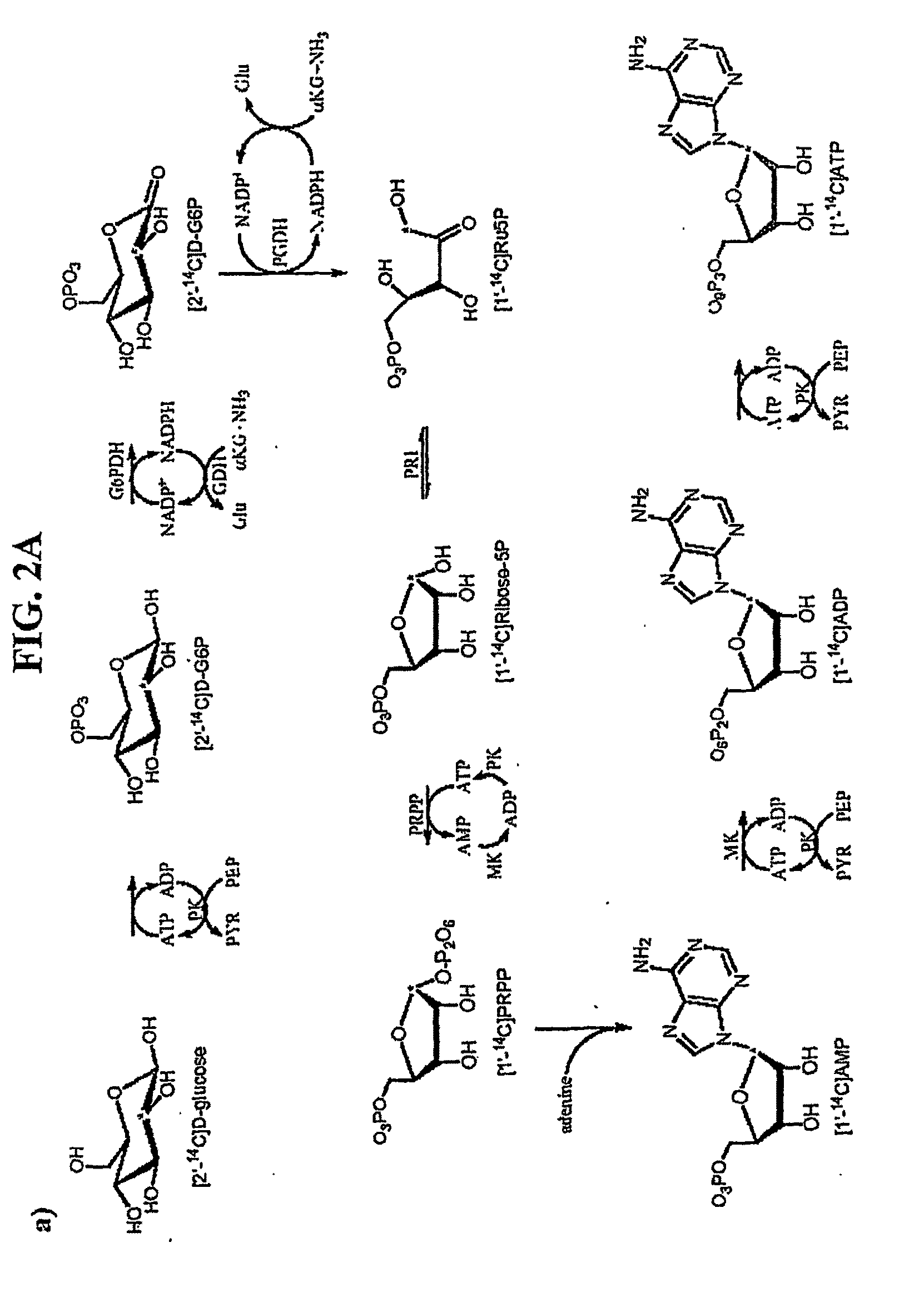Transition state sturcture of 5'-methylthioadenosine/s-adenosylhomocysteine nucleosidases
a technology of s-adenosylhomocysteine and transition state, which is applied in the direction of sugar derivates, antibacterial agents, biocide, etc., can solve the problem of not being able to design “perfect” transition state analogues
- Summary
- Abstract
- Description
- Claims
- Application Information
AI Technical Summary
Benefits of technology
Problems solved by technology
Method used
Image
Examples
example 1
Transition State Structure of 5′-Methylthioadenosine / S-Adenosylhomocysteine Nucleosidase from Escherichia coli and Similarity to Transition State Analogues
Example Summary
[0136]Methylthioadenosine / S-adenosylhomocysteine nucleosidase (MTAN) catalyzes reactions linked to polyamine metabolism, quorum sensing pathways, methylation reactions and adenine salvage. It is a candidate target for antimicrobial drug design. Kinetic isotope effects (KIEs) were measured on the MTAN catalyzed hydrolysis of 5′-methylthioadenosine (MTA) to solve the transition state structure. KIEs measured at pH 7.5 were near unity due to large forward commitment to catalysis. Intrinsic KIE were expressed by increasing the pH to 8.5. Intrinsic KIEs from MTAs labeled at [1′-3H], [1′-14C], [2′-3H], [4′-3H], [5′-3H], [9-15N] and [Me-3H3] were 1.160±0.004, 1.004±0.003, 1.044±0.004, 1.015±0.002, 1.010±0.002, 1.018±0.006 and 1.051±0.002, respectively. The large [1′-3H] and small [1′-14C] KIEs indicate that the E. coli MTA...
example 2
Transition State Analysis of S. pneumoniae 5′-Methylthioadenosine Nucleosidase
example summary
[0165]Kinetic isotope effects (KIEs) and computer modeling are used to approximate the transition state of S. pneumoniae 5′-methylthioadenosine / S-adenosylhomocysteine nucleosidase (MTAN). Experimental KIEs were measured and corrected for a small forward commitment factor. Intrinsic KIEs were obtained for [1′-3H], [1′-14C], [2′-3H], [4′-3H], [5′-3H2], [9-15N] and [Me-3H3] MTAs. The intrinsic KIEs suggest an SN1 transition state with no covalent participation of the adenine or the water nucleophile. The transition state was modeled as a stable ribooxacarbenium ion intermediate and was constrained to fit the intrinsic KIEs. The isotope effects predicted a 3-endo conformation for the ribosyl oxacarbenium-ion corresponding to H1′-C1′-C2′-H2′ torsional angle of 70°. Ab initio Hartree-Fock and DFT calculations were performed to study the effect of polarization of ribosyl hydroxyls, torsional angles and the effect of base orientation on isotope effects. Calculations suggest that the 4′-3H K...
PUM
| Property | Measurement | Unit |
|---|---|---|
| Volume | aaaaa | aaaaa |
| Fraction | aaaaa | aaaaa |
| Fraction | aaaaa | aaaaa |
Abstract
Description
Claims
Application Information
 Login to View More
Login to View More - R&D Engineer
- R&D Manager
- IP Professional
- Industry Leading Data Capabilities
- Powerful AI technology
- Patent DNA Extraction
Browse by: Latest US Patents, China's latest patents, Technical Efficacy Thesaurus, Application Domain, Technology Topic, Popular Technical Reports.
© 2024 PatSnap. All rights reserved.Legal|Privacy policy|Modern Slavery Act Transparency Statement|Sitemap|About US| Contact US: help@patsnap.com










